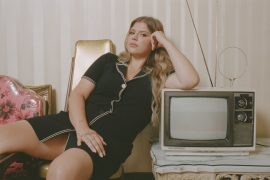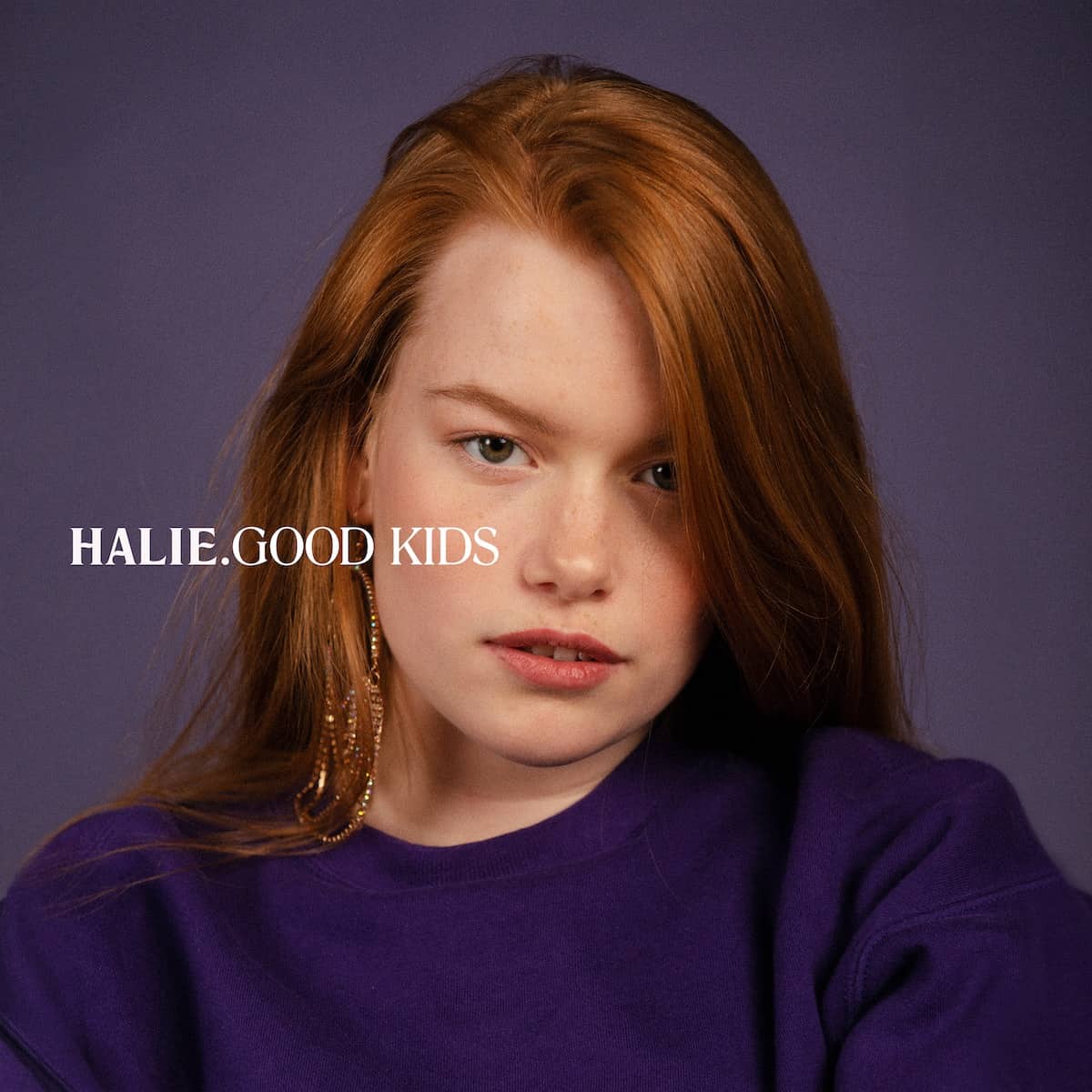Laura Stevenson’s sixth LP is a “purge and a prayer” — it’s her most vivid work to date, rife with rage and atonement, heartbreak and peace.
Stream: ‘Laura Stevenson’ – Laura Stevenson
The cover of Laura Stevenson’s self-titled sixth record, a beautiful painting by Kaitlin Van Pelt, shows Stevenson and her infant daughter in her family’s living room. The image is placid, colored with soft hues and pastel gradients; the look on Stevenson’s face is equally peaceful. Harry Nilsson gazes down from the wall and all seems well. The painting was based on a photo of Stevenson, who said in a recent interview with Spin, “This one is the most me I’ve ever felt in a photograph…It was perfect.”

The painting’s peacefulness is incongruous with the album’s content. Laura Stevenson (out August 6, 2021 via Don Giovanni Records) was inspired by the terrifying near-death experience of a loved one, whose recovery Stevenson became intimately involved with. To protect the privacy of the individuals involved in the crisis, Stevenson has remained vague on its specifics. But even without details, the record is an intense portrait of intense uncertainty, fear, atonement, and devastation.
After returning home, struggling with what she would later recognize as PTSD, she wrote what would become the album’s final song: “Children’s National Transfer.” The song is a self-contained moment of calm, recounting the minutiae of daily life that occur even in the midst of tragedy. It is in sharp contrast to album opener, “State,” a visceral expulsion of rage and perhaps the most forthright song in Stevenson’s entire catalogue. “I’m in a state again / but I stay polite / I stay polite / It keeps me alive,” she sings over a bed of intensifying guitar and the harsh birdcall of cello harmonics.
And I make amends, and fake it when I count the dead.
And I make amends to everyone that I’ve left standing.
Did I shirk something?
Did I hurt someone?
Was I ever any good? I know, I know, I know I was.
– “Sky Blue, Bad News,” Laura Stevenson
“You blame yourself because it’s the easiest way that you can put all the pieces together and try to make sense of a completely senseless situation,” Stevenson says; desperation to “make amends” is an idea that finds its way into many of Laura Stevenson’s songs. On the Nilsson-esque ballad “Mary,” a typically non-religious Stevenson pleads with a highway statue of the Virgin Mary for “mercy.” Crisis often comes in waves, and Stevenson navigates its various stages with her signature thoughtfulness and depth.
For over a decade, Stevenson has shared the intimacy of her music with avid fans — Laura Stevenson may be her most exacting work yet, filled with sharp imagery and harrowing melodies. Her voice is at its best, and her band (which also features longtime collaborator Jeff Rosenstock on guitar) follows suit. Though it is a painful album, it is also one with immense power to heal. Atwood spoke with Stevenson about the album, living through trauma, and honesty in songwriting.
— —
:: stream/purchase Laura Stevenson here ::

A CONVERSATION WITH LAURA STEVENSON

Atwood Magazine: I’m always so curious about what makes a self-titled record. What made this the one to bear your name as both creator and title?
Laura Stevenson: I just felt so secure with the evolution of my songwriting with this record. I felt so confident in a way that I’d never felt before and so excited about where I was going that I was like, “Yeah, this is the one,” even though it’s my sixth record, which is kind of bizarre. I always have a hard time naming records, but I felt so proud of the songs and their content, as well as the growth that I experienced while creating it, that this was the one for me.
You’ve described this album as a “purge and a prayer.” How has your relationship to this record changed since you started writing it and since you recorded it?
Laura Stevenson: When I was writing it, there was still so much uncertainty with the situation that was occurring. That’s the prayer part. The purge was getting all that out. But the prayer was just this desperate clawing for some hope and for a resolution. Resolutions never fully come, but things have settled so much. So now I’m looking at it from a further perspective where everything has fallen into the place that it’s fallen into. And now we’re looking back on this experience and learning from it and drawing strength from it.
I’m sure that with something as big as this was, your feelings surrounding it have changed a lot over time.
Laura Stevenson: Yeah, it feels like our lives are forever changed — for all the people involved. And my life had been changing so much personally within my home, throughout the creation of the record. There are so many points along the way where you’re looking back at what happened, and you’re growing from it in different ways. It’s been really interesting now, practicing these songs and talking about these songs with people. It’s helping me so much. The people involved got in touch after [the Spin article], and they were like, “This is beautiful. Thank you for making art from what happened.” That’s difficult thing for the people that are directly on top of it to do when they’re also just trying to f*cking live. I could come home and process everything, and then make what I made; if it can help them process their shit, then it really is such a blessing.
There’s this frequent reference of making amends or atonement on this record, which is interesting considering this record is also so much about outward rage at something that happened to someone. How did you approach those contradictions?
Laura Stevenson: I think when you’re going through something that’s so out of your control, there’s a tendency to try to rationalize and try to place blame on yourself that is completely inappropriate — like, “I did this bad thing in my life. Is that why all this bad shit’s happening to these other people that have nothing to do with it? Did I put some sort of bad energy into the world and now it’s come back to suck us all in?” You blame yourself because it’s the easiest way that you can put all the pieces together and try to make sense of a completely senseless situation. I was grappling with all these feelings that were completely irrational, but that’s how people process things. They just blame themselves. It’s s unfair to do, because you’re grieving, why kick yourself while you’re down, but eh — the process [laughs].
It feels like a very female thing to do, too – women are expected to sublimate rage and this album feels like it’s really grappling with that. Or the idea that women should handle tragedy with grace.
Laura Stevenson: That’s a very astute observation. I didn’t even put it in that context. In my mind, I was just like, experiencing it as a woman [laughs]. But yeah, I think if you’re trying to understand it at its core, I definitely have that caretaker desire, where I am running to help and hold things together. Doing that f*cking destroyed me. After all that happened, I came home and was waking up in a panic and seeing all these horrible images. It was definitely PTSD. For months, I just couldn’t get it together. I was destroying my home life, pushing everyone away. I completely crumbled because I was trying to be the person that held everyone together during this crisis. As a kid, that was me and my family. I was the one that tried to fix everything. That is, unfortunately, a role that tends to be a female role in our culture. And that’s f*cked up. I haven’t really been thinking about it through that lens.
It was the switch that happens in “State” that made me think of it, where there's that huge cacophony of guitars and then it becomes that really pretty ending.
Laura Stevenson: Wow. Yeah, absolutely. Absolutely. It’s just like, you’re so seethingly angry and all this rage is coming out, and then you just suck it back. And you’re like, “Yep. Keep it together, Stevenson.” [laughs]
What was the first song that you wrote for this record?
Laura Stevenson: The first song that I wrote was the last song [“Children’s National Transfer”]. Right when I came home, that was the first thing I wrote. I wrote it on this little piano in my garage studio that overlooks these trees. I wrote the song in like, two minutes. It was such a special song for me. Then there was a big gap in my writing after that. It took me several weeks to come back and be like, “Okay, let’s parse through some more of this shit. Try to figure this out.” But that one came out of this little moment that was so special and poignant. I just had to capture it.
I love the first line of that song, “No one knows me in this store.” What does that feeling mean to you?
Laura Stevenson: It was a moment of anonymity, as in, “Nobody knows what I’m going through.” I wrote it for one of the people involved. It was a moment from their experience of being in a store and having a second to pick up some bullshit that does not nourish [their] body at all, like diet soda and cigarettes. It was completely frivolous, but it’s like, “I’m here. Nobody knows what f*cking tragic terror is engulfing me right now. I can just live outside of that. Nobody has to feel bad for me. I’m just a regular person for two seconds, doing what I always used to do — going into a store, looking at all the bullshit, and the shiny lights and the fluorescent shit and having that little pocket of breath.” It was like the eye of the storm. Because then they left the store and continued on to the rest of everything that was going on. When the person told me, “Oh, I stopped and got cigarettes and soda, and it felt so good to just exist for a second”, I carried that with me. I thought it was so beautiful and necessary, for a human being to be able to breathe for a second and try to remember who you were and what you used to like to do.
This album is so vivid despite the obfuscation of the events that inspired it. When you’re writing something like this, how do you handle this balancing act?
Laura Stevenson: There were a couple songs that I thought were too much that I left off. But I feel like the ones that remained on the record, I didn’t have to put a veil over. I said what I wanted to say, but there were a couple of songs that I thought were inappropriately close. So the two or three songs that couldn’t go on the record were just for me.
I was curious if anything had changed.
Laura Stevenson: That’s the only thing that changed about the writing of the record — that one line, because it was so on my mind. The recording would have gone as planned, but it definitely hit me harder. I was reliving that stuff, and then I was reliving it through this new perspective of this other person that I made. I brought her into this world and I’m like, “What am I, out of my mind?” Like, oh my God. There’s a lot of guilt there. “I created a life in this world? That’s f*cked up.” But I did it, and so now I’m like, I gotta protect this kid. Hardcore.
There’s a real sense of the passage of time on this record — like “nothing creeps like measured time” on “Moving Cars” and everything on “Sky Blue, Bad News.”
Laura Stevenson: There’s the juxtaposition of time being able to heal, but also how waiting opens up all those wounds. The further you move away from an event, if it hasn’t resolved itself, it remains just as raw. It’s never gonna be fully resolved, which is the infuriating part of it. Now, time feels more like my friend than it did. Things have settled as much as they’re going to. Anniversaries of bad things that happened are getting a little bit easier, for sure. But I was definitely exploring all those concepts. I was thinking at the time that things should be feeling better, but they’re not somehow. And I brought it all with me back home. Moving myself physically out of the situation and letting time go by was not healing me whatsoever. I needed to actually seek some help for it because I was just completely imploding.
“Mary” is such a beautiful song. Can you talk about that one?
Laura Stevenson: The way the chords move was my nod to [Harry] Nilsson. That song is really f*cking serious. There’s no bones about it. Sometimes I get nervous or like, cringey, when I listen to things where I’m purely serious, but that’s a special one. I’m not a religious person at all, but with that song, I was driving to where I needed to go to be with these people. There is this giant statue of the Virgin Mary on the side of the road that always loomed over you and made me feel really uncomfortable. But I was stuck in traffic and staring at it, crying about everything. I was like, “If you’re real, help us. If anything is real, we need help.” I look at it now like, “What was I doing?” But in those moments of desperation, you are willing to believe in anything if it will help. That song was exploring that feeling of being open to something otherworldly swooping in to protect people.
This record is obviously so personal, but it’s also expressing such universal feelings like grief and fear. Putting this out into the world now, what are you most hoping to convey? Or what are you hoping people leave the album feeling?
Laura Stevenson: I’m hoping for hope, I guess. I made it because I was hoping. It is such a powerful thing, and it helps people persevere in a lot of circumstances. When I decide to share things into the world, I only do it if I feel like it’s gonna have some sort of positive impact. I hope that people can draw some strength from it in moments where they’re really looking for something.
The last time I talked to you, we talked about the line “I need to stop singing in code” on “Beets Untitled” from A Record. You mentioned last time that you felt that The Big Freeze was you at your most honest. This record feels honest in a very different way – looking back, do you still feel that way? Do you feel like you’ve gotten to a place where you’re no longer singing in code?
Laura Stevenson: When I wrote The Big Freeze, I was like, “This is the most open I’m ever going to be an or ever have been.” I think I’ve been challenging myself to get that much closer to the truth. It’s that journey of self-exploration, which lends to the title even more. I’m trying to find the closest thing to what’s inside my brain and my heart and put it into the world as best I can. I guess that’s always going to be the journey until you like, create something transcendent, and then you just just disappear into a cloud [laughs].
— — — —

Connect to Laura Stevenson on
Facebook, Twitter, Instagram
Discover new music on Atwood Magazine
? © Bon Jane
:: Stream Laura Stevenson ::









